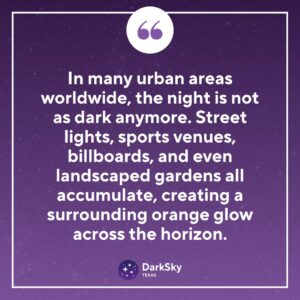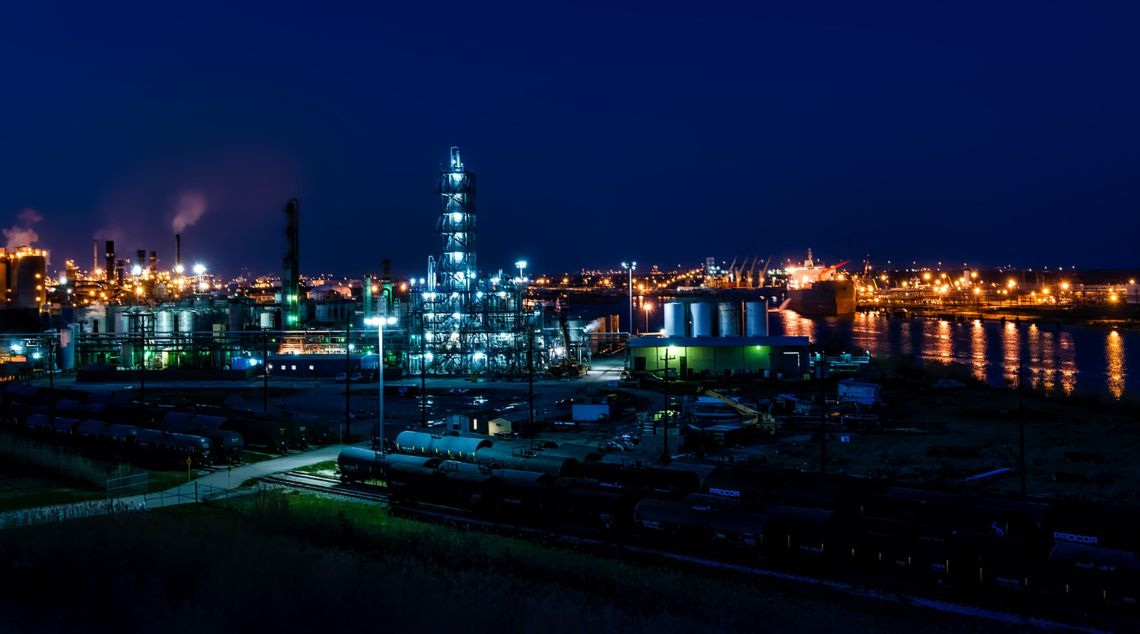When we hear pollution, most think of oil spills, smog, or floating plastic islands. But light can also pollute our night skies!
At DarkSky Texas, volunteers, educators, and partners are working together towards a single goal: guarding the night sky from light pollution.
This mission takes many forms. Our greatest tool? Education. If this is the first time you’ve heard about “light pollution,” the term may seem puzzling. How can light be polluting if it’s just there? Is darkness something we should preserve? This guide will help you understand light pollution and its causes.
What is Light Pollution?
When we talk about “light pollution in Texas” we are talking about how artificial, man-made lights are creating glare and light trespass as well as changing the look of the night sky here in the Lone Star state.
For millennia, we’ve associated light as “good” and darkness as “bad” or “dangerous.” In reality, dark night skies, lit only by the stars and moon, are essential for nature’s cycles and even for our biological clocks.
However, in many urban areas worldwide, the night is not dark anymore. Street lights, sports venues, billboards, and even landscaped gardens all accumulate, creating a surrounding orange glow across the horizon.
Now, in many areas, traveling down most streets without encountering glary lights or just observing the stars from your home is nearly impossible. Migrating birds and local wildlife get disoriented and many die as a result. Plants change their growth patterns.
How Widespread is Light Pollution?
According to the National Geographic Society, more than 80% of the world’s population lives somewhere affected by light pollution. This includes nearly 99% of people in North America and Europe.
Think about it! Most of us now look at a very different night sky than our great-grandparents.
And yet, if you live in a city, outdoor lights are an unquestionable necessity. However, we can do something about the intensity, the color, and the shielding of outdoor lights. In many cities, night lights have created a noticeable halo for over 50 miles beyond the city limits, which sometimes remains visible for over 150 miles.
In Texas, light pollution covers most of the Southeast Coast, including most of the land between the Houston, San Antonio, and Dallas Triangle. We can still find areas where darkness remains untouched in the Western side of the state and the Panhandle. However, the city lights scattering from Amarillo, Lubbock, and El Paso continue to grow year by year. And, oil field lights are illuminating the once naturally dark areas of Texas.
How does Light Pollution Work?

Light pollution is something we can easily see. And yet, in some places, light pollution is more intense than in others. This doesn’t necessarily match the number of houses or buildings in a specific area.
Light pollution comes from outdoor lighting sources, but not all outdoor lights are created equal. Depending on how you place them or the type of bulb you use, light pollution can create a contained area of bright lights or scatter around for miles.
Types of light pollution
Light pollution can be classified into three types: line-of-sight lights (or direct light trespass), glare, and skyglow.
Light trespass
Light trespass happens when light falls outside the area it was designed to brighten. If you can see the source of the light from a property other than the one where the light is installed, that light is creating light trespass. Artificial lighting from off-site can destroy an owner’s ability to enjoy their property. This unwanted light trespassing onto another’s property is a nuisance.
Often, this light is not bright enough to be “useful” but just strong enough to cause glare and interference. Think of a neighbor’s light that is directed toward your bedroom, entering through the window. It’s unlikely to replace your indoor lights – it won’t let you read – but it will disrupt your sleep.
Glare
Glare happens when some light rays are directed or reflected directly into your eyes making it difficult to see. This often happens when outdoor lights or bright car lights are directed so that you see the source of the light rather than the illumination. Glare can be physically uncomfortable and even dangerous, as it can create a “blind spot” or “disabling glare”.
Skyglow
Skyglow is the dome of light covering most cities and urbanized areas. Occasionally, a single property with multiple bright lights can create skyglow above it that can be seen for miles around. Skyglow can range from yellow-orange in heavily contaminated areas to a milder purple tint as it wears off. It is formed by the combined scattered light from many sources simultaneously. In areas affected by skyglow, you won’t be able to see many stars, or the Milky Way, with the naked eye.
How do we Detect Light Pollution?
Light trespass and glare are usually localized spots, so you’ll hardly see anyone measuring them unless they are on a critical spot – for example, glare near a highway can cause roadside accidents. Illumination will certainly be seen from another property but light trespass and glare are present If you can see the source of light – the bulb or LED – from another property.,
Skyglow, on the other hand, is a bit more complex. To measure the extent and reach of skyglow, we need to consider how the light is distributed, if it’s reflecting on anything else, how far it travels, and how intense it is. The weather (especially humidity) can often worsen skyglow, as the light will bounce off the small particles of water in the air.
Skyglow measurements must be taken at ground level, not from the sky. Light pollution researchers and activists often use a Sky Quality Meter to measure it. For accurate measurements, several measurements are often taken in the same area.
The Good News: It’s Reversible!
Light pollution impacts every species on Earth. Fortunately, unlike ocean spills or noxious gasses, eliminating its effects won’t require complicated clean-up operations or expensive filters.
Instead, we need homeowners, landscapers, and businesses to rethink how and where we place outdoor lights.
We can all bring back the natural dark sky of centuries past, while having the light we humans need, through smart engineering practices, a few retrofits, and the honest will to help. Learn more about reducing light pollution here and subscribe to stay involved.
Image Source: Canva


